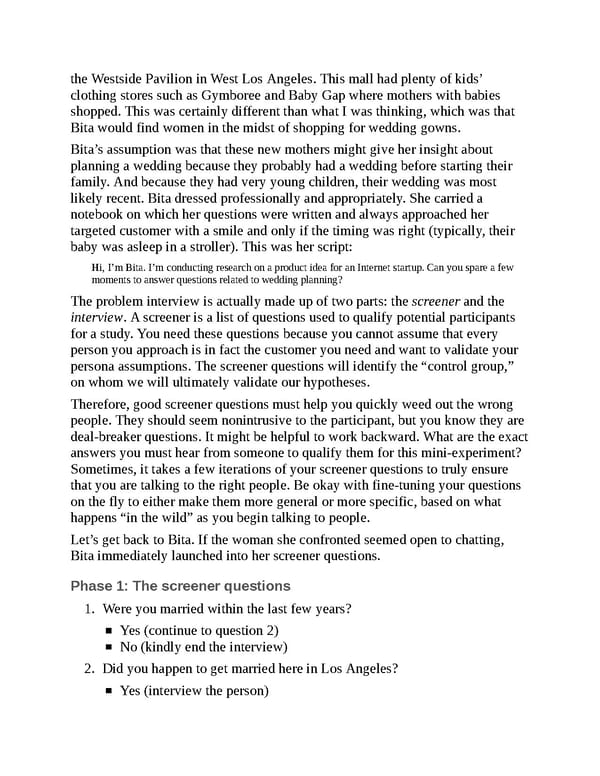the Westside Pavilion in West Los Angeles. This mall had plenty of kids’ clothing stores such as Gymboree and Baby Gap where mothers with babies shopped. This was certainly different than what I was thinking, which was that Bita would find women in the midst of shopping for wedding gowns. Bita’s assumption was that these new mothers might give her insight about planning a wedding because they probably had a wedding before starting their family. And because they had very young children, their wedding was most likely recent. Bita dressed professionally and appropriately. She carried a notebook on which her questions were written and always approached her targeted customer with a smile and only if the timing was right (typically, their baby was asleep in a stroller). This was her script: Hi, I’m Bita. I’m conducting research on a product idea for an Internet startup. Can you spare a few moments to answer questions related to wedding planning? The problem interview is actually made up of two parts: the screener and the interview. A screener is a list of questions used to qualify potential participants for a study. You need these questions because you cannot assume that every person you approach is in fact the customer you need and want to validate your persona assumptions. The screener questions will identify the “control group,” on whom we will ultimately validate our hypotheses. Therefore, good screener questions must help you quickly weed out the wrong people. They should seem nonintrusive to the participant, but you know they are deal-breaker questions. It might be helpful to work backward. What are the exact answers you must hear from someone to qualify them for this mini-experiment? Sometimes, it takes a few iterations of your screener questions to truly ensure that you are talking to the right people. Be okay with fine-tuning your questions on the fly to either make them more general or more specific, based on what happens “in the wild” as you begin talking to people. Let’s get back to Bita. If the woman she confronted seemed open to chatting, Bita immediately launched into her screener questions. Phase 1: The screener questions 1. Were you married within the last few years? Yes (continue to question 2) No (kindly end the interview) 2. Did you happen to get married here in Los Angeles? Yes (interview the person)
 UX Strategy: How to Devise Innovative Digital Products that People Want Page 69 Page 71
UX Strategy: How to Devise Innovative Digital Products that People Want Page 69 Page 71